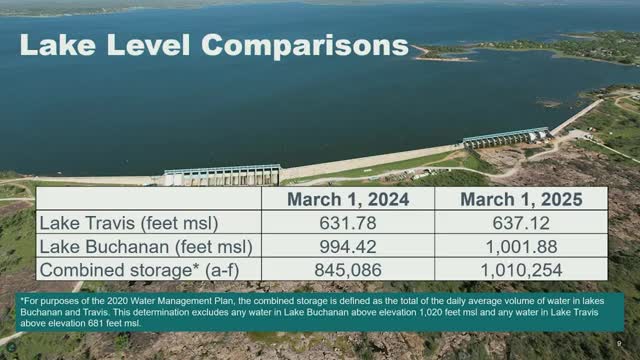Water Manager confirms Arbuckle reservoir ready for summer industrial supply
March 28, 2025 | Lower Colorado River Authority (LCRA), Departments and Agencies, Executive, Texas
Thanks to Scribe from Workplace AI , all articles about Texas are free for you to enjoy throughout 2025!

This article was created by AI using a video recording of the meeting. It summarizes the key points discussed, but for full details and context, please refer to the video of the full meeting. Link to Full Meeting
This development comes at a time when the region is experiencing a weak La Niña, with forecasts suggesting a shift to ENSO neutral conditions in April. While this change is generally favorable, the Climate Prediction Center warns of average to below-normal rainfall in the coming months, which could impact water availability.

Before you scroll further...
Get access to the words and decisions of your elected officials for free!
Subscribe for FreeThe Arbuckle Reservoir, which can hold up to 90,000 acre-feet of water, is anticipated to provide much-needed flexibility in water management, especially for industrial users in the Gulf Coast area. Currently, agricultural water supply is turned off for certain lower basin users, but the reservoir will allow LCRA to meet the needs of industrial customers more efficiently. This is particularly important as the demand from existing industrial users is estimated at around 20,000 acre-feet annually, with additional demand expected from new customers.
The board emphasized that the successful operation of Arbuckle represents a significant milestone, as discussions about the reservoir began over a decade ago. The ability to dispatch water from Arbuckle not only enhances the LCRA's water management capabilities but also supports environmental flows to the bay, ensuring a balanced approach to water distribution.
As the LCRA moves forward with testing and operational planning, the community can look forward to a more resilient water supply system that addresses both current and future demands. The integration of Arbuckle into the water management strategy is a positive step toward ensuring sustainable water resources for the region.
Converted from LCRA Board meeting March 26, 2025 meeting on March 28, 2025
Link to Full Meeting
Comments
View full meeting
This article is based on a recent meeting—watch the full video and explore the complete transcript for deeper insights into the discussion.
View full meeting




